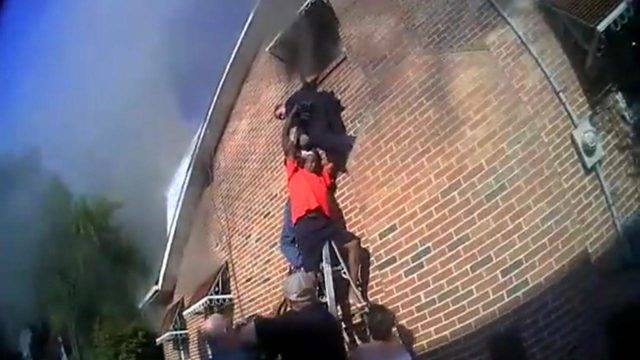Strip Mall Fire Simulation


Firefighter T-Shirts
and rescue profile. Recognizing is seeing a pattern based on the critical cues observed. Finally, reacting is choosing a course of action that is likely to affect the outcome of the incident based on your prior experience with similar events. Naturalistic decision-making researcher Gary Klein describes this process as recognition primed decision making or RPMD. In order to develop these “soft skills” it is necessary to gain experience in a wide variety of incident situations. Training with incident simulations is one way to accomplish this goal.
In this month’s strip mall fire simulation, you are the Engine 1 officer and will be first due at the incident. You are in quarters when the following dispatch comes in: “Engine 1, Engine 2, Engine-3, Ladder 1, and Battalion 1, respond to 8246 Menaul Blvd at the Wing Basket restaurant in the Hoffmantown shopping center.”
RELATED: Lessons Learned at FDIC Help Save Strip Mall | Humpday Hangout: Fires in Strip Malls, Part 1 Part 2 | What Would You Do? Strip Mall Fire
The Hoffmantown shopping center was constructed in the early 1950s of ordinary construction. The various occupancies have changed hands many times over the years and there have been numerous renovations, as well. There is no built-in fire protection system and no basement. When you arrive on scene, you are met by the Wing Basket restaurant manager, who informs you they had a grease fire in the kitchen that they tried to put out with portable extinguishers but is now out of control. He states that everyone is out of the restaurant.
Start the strip mall fire simulation video above. You will be prompted to pause the video and give a radio report at several key points.
The first radio transmission you will provide is a standard size-up report. This radio report should include the following elements:
- Arrival on scene
- Building area/size
- Building height (number of stories)
- Problem description
- Action being taken (assignments for the E-1 crew)
- Assume and name command
- Any resource needs
The size of this strip mall makes it impractical for you as the Engine 1 officer to conduct a 360° survey of this building.
You will be prompted to pause the video and make an assignment when additional units report on scene. Practice giving assignments using the Task, Location, Objective (TLO) format. An example assignment might be: “Ladder 1 pull a second handline from Engine 1, (Task) go to the first floor (Location), get an “all clear,” and check for fire extension.” (Objective)
When Battalion 1 arrives on scene, make a command transfer using your department’s standard command transfer process (if applicable).
Formulate Conditions, Actions, Needs (C.A.N.) reports for the assigned units based on the visible conditions and information provide when prompted to do so.
Finally, have Battalion 1 give an assignment to Engine 3 using the TLO format based on the C.A.N. reports from the assigned units.
The most effective way to use the simulation is to get feedback regarding your performance (have an experienced officer or colleague critique your radio reports) and run through the simulation again, incorporating the feedback.
RELATED: Lessons Learned at FDIC Help Save Strip Mall | Humpday Hangout: Fires in Strip Malls, Part 1 Part 2 | What Would You Do? Strip Mall Fire
The Hoffmantown shopping center was constructed in the early 1950s of ordinary construction. The various occupancies have changed hands many times over the years and there have been numerous renovations, as well. There is no built-in fire protection system and no basement. When you arrive on scene, you are met by the Wing Basket restaurant manager, who informs you they had a grease fire in the kitchen that they tried to put out with portable extinguishers but is now out of control. He states that everyone is out of the restaurant.
Start the strip mall fire simulation video above. You will be prompted to pause the video and give a radio report at several key points.
The first radio transmission you will provide is a standard size-up report. This radio report should include the following elements:
- Arrival on scene
- Building area/size
- Building height (number of stories)
- Problem description
- Action being taken (assignments for the E-1 crew)
- Assume and name command
- Any resource needs
The size of this strip mall makes it impractical for you as the Engine 1 officer to conduct a 360° survey of this building.
You will be prompted to pause the video and make an assignment when additional units report on scene. Practice giving assignments using the Task, Location, Objective (TLO) format. An example assignment might be: “Ladder 1 pull a second handline from Engine 1, (Task) go to the first floor (Location), get an “all clear,” and check for fire extension.” (Objective)
When Battalion 1 arrives on scene, make a command transfer using your department’s standard command transfer process (if applicable).
Formulate Conditions, Actions, Needs (C.A.N.) reports for the assigned units based on the visible conditions and information provide when prompted to do so.
Finally, have Battalion 1 give an assignment to Engine 3 using the TLO format based on the C.A.N. reports from the assigned units.
The most effective way to use the simulation is to get feedback regarding your performance (have an experienced officer or colleague critique your radio reports) and run through the simulation again, incorporating the feedback.














